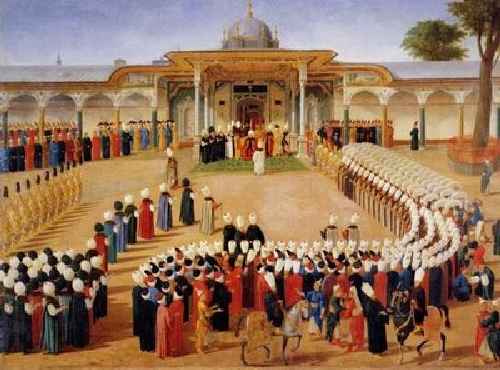
At the pinnacle of the Ottoman hierarchy was the sultan-caliph, an absolute monarch whose right to rule was derived from his membership in the house of Osman. As the Ottoman state changed from a ghazi principality to a world empire, the sultans instituted an imperial council, or divan, to deal with the increasingly complex affairs of government. The divan was presided over by the grand vizier, the most powerful official in the government hierarchy whose court was referred to as the Bab-i Ali, or Sublime Porte, most usually in the context of Ottoman diplomacy. He was the absolute deputy of the sultan and acquired the right to exercise executive authority in the sultan’s name. During the reigns of weak sultans, the grand viziers sometimes assumed extensive powers and made decisions without consulting the monarch.
The three major groupings within the Ottoman ruling elite were the military, the civil service, and the religious establishment. The two main branches of the Ottoman armed forces came from quite different sources. The provincial cavalrymen, or sipahis, were freeborn Muslims who fulfilled an administrative as well as a military function. In an attempt to maintain a large army without making huge cash payments, the sultans awarded sipahis the rights to the income from agricultural land, known as timars. Each sipahi was assigned a specific timar from which he was allowed to collect the taxes that served as his salary. In return, the sipahi was expected to maintain order in his timar, to report for military service when called on by the sultan, and, depending on the size of his income, to bring with him a certain number of armed and mounted retainers.
Although sipahis and their retainers made up the bulk of the Ottoman armies, the most efficient imperial military unit was the professional standing infantry corps known as the Janissaries. In the fourteenth century, the Ottomans institutionalized a method for procuring slaves from among their European Christian subjects. Known as the devshirme, a collecting system, it consisted of a levy every few years on adolescent male Christian children from the European provinces of the empire. The children were removed from their families and taken to Istanbul, where they were converted to Islam, tested and screened, and then trained for service in the empire. Most of them were eventually enrolled in the ranks of the Janissary corps, which, at its peak in the fifteenth and sixteenth centuries, was the outstanding military unit in Europe.
As a centralized imperial state, the Ottoman Empire was characterized by an immense and elaborate bureaucracy. The Ottomans drew on the administrative traditions of the Byzantines, the Iranians, and the Arabs to create a highly differentiated civil service. Most of the middle-level Ottoman civil servants were freeborn Muslims who received on-the-job training as apprentices in one of the several ministries. Along with the bureaucratic and military elite, the ulama formed the third pillar of the Ottoman ruling class. The Ottomans endeavored to establish shari ’ ah norms of justice by organizing the qadis, judges, into an official hierarchy and arranging for their appointments in the various administrative subdivisions of the empire. Over the course of time, an official known as the shaykh al-Islam emerged as the chief religious dignitary of the empire. He oversaw the appointment of qadis and madrasah teachers in the far-flung Ottoman territories and acquired status as the official whose legal opinion the sultans sought when they contemplated the introduction of certain administrative and fiscal measures.